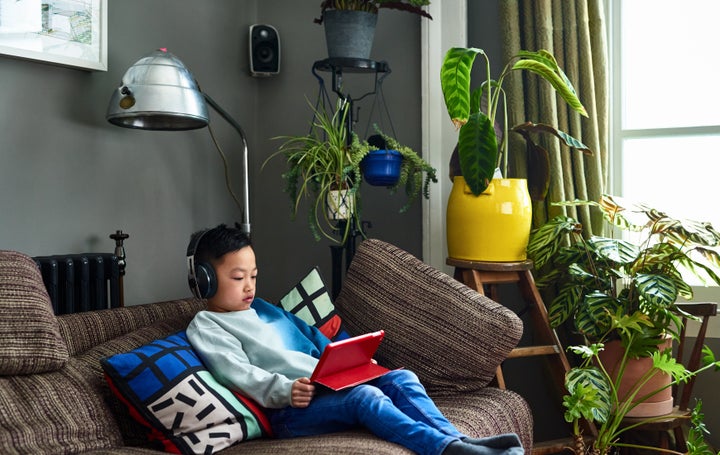
The COVID-19 pandemic has pushed many of our day-to-day endeavors online ― school, work, fitness, socialization, and even mental health care. But when it comes to therapy, the virtual medium can present challenges, particularly for young people.
“It is sometimes more difficult to engage kids in sessions conducted via telehealth,” said Nicole Schatz, research assistant professor and clinic director at Florida International University’s Center for Children and Families. “Although many kids are able to engage with telehealth sessions just fine, some may benefit more from in-person treatment sessions.”
Speaking to a therapist through a screen from home can present concerns about privacy for kids and teens feeling their close proximity to family members. There may also be distractions, discomfort and a sense of distance that make opening up and engaging with therapy difficult.
But even if in-person sessions aren’t an option at the moment, there are still ways to deal with some of these challenges. That’s where parents and caregivers come in.
So what exactly can parents do to encourage their children to open up in remote therapy and have a healthy and productive experience? Below, Schatz and other experts share their advice.
Respect their privacy.
“Privacy can sometimes be a challenge during telehealth,” Schatz said. “Sessions may be interrupted by siblings or other family members coming into the room. Kids may also have concerns that others in their household will overhear the session from another room.”
Parents can help with privacy concerns by ensuring their children have a quiet, secure space for therapy sessions where they don’t have to worry about interruptions or eavesdropping. They may also offer headphones to create a more one-on-one feeling and help their kids isolate themselves from their surroundings.
“Allowing a child the time and space for their therapy conveys that therapy is important and also conveys respect for privacy,” said Allison DePoy, behavioral health clinical educator with Big Lots Behavioral Health Services at Nationwide Children’s Hospital in Ohio.
On the other hand, small children might feel intimidated by teletherapy and want a parent present, at least at first. Parents should talk about this option with the therapist and child to determine the most effective approach.
“Discuss with your child ahead of time the limitations and benefits of online therapy,” advised Bethany Cook, a music therapist and clinical psychologist in Chicago. “Ask your child where they would like you to be during the session ― in the room or out of earshot?”
Create a comfortable therapy environment.
In addition to privacy, parents should help their child find a space that feels comfortable and conducive to productive therapy sessions. Have them test out their therapy spot before the session to make sure they feel relaxed.
“See if they want to have drinks or snacks handy,” recommended Sanam Hafeez, a New York-based psychologist. “Do they prefer a bright environment with windows open, or something darker? Is there an option to do a session safely in a backyard so they can be in the sun? Talk to your kids about what would make the session most appealing for them so they can maximize the benefits.”
“For younger kids, reduce distractions,” DePoy said. “Turn the TV off and limit the number of toys in the room where the session is being held. Allow the child to select some specific items that might be helpful in therapy.”
Many therapists incorporate art, music or game play into sessions to keep kids engaged.
“Finding a game that can be played online or with the use of a whiteboard feature is a nice way to have a shared experience through the virtual platform,” DePoy noted. “Making therapy a fun experience can also curb some of the virtual fatigue. If therapy is a virtual activity the child looks forward to, they are less likely to resist logging in for their session.”
Your child’s therapist may advise keeping paper and pens in the room for drawing or specific toys or items that could be useful for the remote session. These are generally things already in the house, but occasionally a therapist may suggest a specific product.
“One strategy I use when working with children with anxiety is teaching breathing techniques using a Hoberman sphere,” said Reena Patel, a licensed educational psychologist in San Diego. “I can only recommend a parent purchase one for home and then show how to use it via Zoom. In a therapeutic setting I could have my patient use the one I have.”
Be flexible with time.
“We’ve seen difficulty with sustained attention for some kids,” DePoy said. “Being on the screen may not feel quite as engaging or energizing as being in a room with someone. Keeping kids, especially younger or more active kids, in front of the camera and engaged in session can be tough.”
She noted that many kids are feeling “virtual fatigue,” with school, social time, grandparent visits and so many other aspects of life happening on a screen.
“Kids who are spending long hours online might benefit from a break from screen time between school and therapy sessions,” Schatz said.
Parents can help facilitate some strategic screen-free time on their children’s therapy days. They may also be on hand to help if the therapist decides a young child would benefit from mid-session breaks for movement or a snack. The main thing is to be flexible.
“Therapists are doing their best to tailor their virtual sessions to their clients’ needs,” DePoy said. “They are offering shorter sessions for children who may not be able to sustain attention for a full therapeutic hour.”

Get comfortable with the technology.
“In general, most kids and families made the transition really well. COVID made this a necessity for a good majority of people and we saw a positive response. That said, technology and connectivity issues definitely have presented a challenge,” DePoy said.
Parents should help their children get comfortable with any new technology like a telehealth platform. They can try to do a trial run with their kids before the first sessions to practice using it.
Families who have the resources should also invest in better internet connectivity as needed. If the wifi isn’t strong in the area of the house where the child does teletherapy, consider upgrading, offering a hotspot or finding a better location. This has been a priority for therapists as well.
“I’ve had times when the wifi signal or computer software just wouldn’t work and sessions were delayed or needed to be rescheduled which is frustrating to everyone,” said Cook. ”I’ve had to upgrade my internet connection and speed due to wifi connection issues and always make sure software is updated before I start a session.”
Therapists can also get creative with virtual backgrounds. They may ask a child to set their background to a photo of a place they like to visit and have a conversation about that place. This is another area where parents may need help out before a session.
Be positive about teletherapy.
“It’s important for parents to convey a positive attitude toward remote therapy,” DePoy noted. “Children of all ages learn from their parents so if they see that their parent or guardian is responding positively to it, they are more likely to respond positively.”
While they can talk about the challenges virtual counseling poses, parents should also show support and encouragement for their children’s teletherapy. If they see a therapist themselves in this way, they should normalize the experience by mentioning that fact in neutral or positive ways. Even if they don’t, caregivers can still help by being open-minded about remote therapy.
“Assuming ‘my child is too young’ or ‘my child won’t benefit’ closes the option before it’s started,” said Rachel Busman, a New York-based clinical psychologist at the Child Mind Institute. Parents who are unsure about teletherapy for their children should reach out to a provider and to chat about their experience, approach to treatment and potential parent involvement.
“A parent appointment with the therapist should always happen first, so the caregiver can explain the concerns and give background information and context,” Busman explained. “Sharing what the child or teen likes will help the clinician build a relationship. Caregivers should also be aware that sometimes treatment involves a parent heavily or exclusively, which is often the case with very young children.”
Communicate with the therapist.
“For kids who are having a difficult time engaging with telehealth treatment, parents can talk with their child’s mental health care provider about strategies to make the sessions more interactive,” Schatz said. “For younger kids, parents might coordinate with the provider and offer a small reward to kids when they do a good job participating in session. If telehealth is not working well, parents can also ask their provider about options for in-person sessions.”
She emphasized the importance of good communication between families and therapists from the outset. When challenges arise, the two can work together to identify potential solutions.
“Ultimately, parents should have a realistic expectation for remote sessions,” DePoy said. “Some kids thrive with virtual sessions, others find them tough. Work with the therapist to tailor the sessions to the child’s unique needs. Some days may be better than others.”